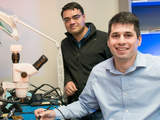UMBC researchers explore virtual and augmented reality
This story was first published on news.umbc.edu. It was written by Megan Hanks.

ABC News in Baltimore took an in-depth look at virtual and augmented reality this week, ahead of Sony’s planned launch of a Playstation virtual reality system. The segment, “Virtual reality opening entertainment, research possibilities,” featured interviews with UMBC faculty on new technologies, the opportunities those technologies create, and issues for users and developers to consider as the field expands.
For viewers unfamiliar with virtual reality, Karl V. Steiner, vice president for research, explained how these technologies allow people to experience the world in a different way. “You put your headset on, you’re in the forest. You could be on a foreign planet or you could be in a battlefield,” he said.

In UMBC’s new PI2 Immersive Hybrid Reality Lab, Jian Chen, assistant professor of computer science and electrical engineering, demonstrated how ultra-high-resolution screens can help researchers visualize complicated data. To experience this technology, users wear 3D glasses with small sensors to enter a world that they can manipulate using handheld controls.
“In this type of environment, your brain thinks your body is moving but your body is not actually moving,” she explained.
The new lab will enable faculty and students in various departments to simulate data in uniquely immersive ways, whether a researcher is exploring wind farms, how blood flows through the human body, or highway traffic, said Steiner.
Ryan Robucci ‘02, computer engineering, and Nilanjan Banerjee, both associate professors of computer science and electrical engineering, are already using HTC Vive headsets in their labs to understand how people make decisions and react when when they are on a battlefield.
Banerjee says that augmented reality technology may be more useful and user friendly than virtual reality systems. Augmented reality allows people to see their surroundings, but alters the world through a device or glasses. Smartphone users are already playing Pokémon GO in huge numbers. In the near future, it could be common to have a technology that, for example, overlays directions and controls onto home appliances.
Watch the full video segment “Virtual reality opening entertainment, research possibilities” on WMAR.
Tags:
Posted: October 8, 2016, 1:00 PM
